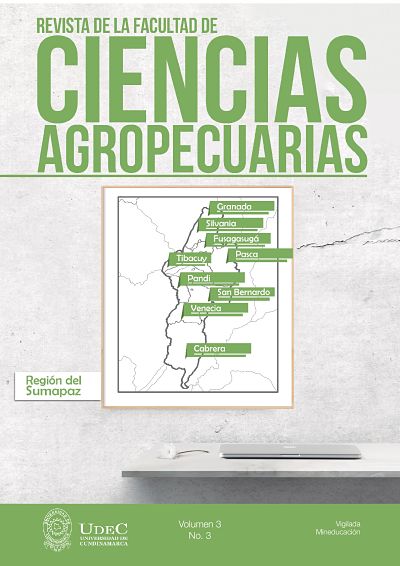Determination of the presence of mercury in the species Pimelodus clarias and in sediments from the confluence of the Bogotá River and the Magdalena River and its possible social impact
DOI:
https://doi.org/10.36436/24223484.223Keywords:
Bioacumulación, ictiofauna, metales pesados.Abstract
The objective of this research was to determine the presence of mercury in the species Pimelodus clarias and in sediments from the confluence area of the Bogotá River with the Magdalena River and its possible social impact on the associated communities in the municipality of Girardot, Cundinamarca. Mercury analyses were performed using the atomic absorption spectrophotometry method and the Past program was used for statistical interpretations. The results show an average mercury concentration in 25 fish samples analyzed of 0.042 ± 0.044 mg / kg, with a minimum value of < 0.001 mg / kg and a maximum value of 0.165 mg / kg, the relationship between the concentration of Hg vs. Size is (r: -0.20) (p: 0.32) and that of Hg vs. weight is (r: -0.16) (p: 0.44). Low concentrations of mercury were found in the sediments, and they are considered viable for cultivation due to a high CEC of 34.69 cmol (+)/kg. In conclusion, although the highest concentration of mercury found in Pimelodus clarias does not reach the internationally accepted limits of 0.5 µg/g to consider them unfit for human consumption, fishing in this area and the consumption of mercury-contaminated foods should be reduced. Furthermore, it is considered that the most important aspect of this study is not the concentrations, but rather the determination of the presence of this highly toxic metal for humans, which could become a public health problem in the region.Downloads
References
Rajeshkumar, S., & Munuswamy, N. (2011). Impact of metals on histopathology and expression of HSP70 in different tissues of Milk fish (Chanos chanos) of Kaattuppalli Island, South East Coast, India. Chemosphere, 415.
PNUMA. (2002). Evaluación mundial sobre el mercurio. Obtenido de Programa de las Naciones
Unidas para el Medio Ambiente: http://www.chem. unep.ch/mercury/GMA%20in%20F%20and%20S/
final-assessment-report-Nov05-Spanish.pdf
Preciado, A. P. (s.f.). El problema del río Bogotá. Sociedad GeoFigura de Colombia. Fallo del consejo de estado, del 28 de marzo de 2014. Disponible en: https://sogeocol.edu.co/documentos/mp20150101_rio_bta.pdf
Instituto Nacional de Salud, Grupo de Evaluación de Riesgos. (2015). Evaluación de riesgo de mercurio en Peces. Bogotá, D. C.
E.U.E.C. (2006). Commission Regulation (EC) No 1881/2006 of 19 December 2006 setting maximum levels for certain contaminants in foodstuffs. Obtenido de http://ec.europa.eu
Trujillo, F., Lasso, C., Diazgranados, M. C., Farina, O.,Pérez, L., Barbarino, A., & González, M. (s.f.). Evaluación de la contaminación por mercurio en peces de interés comercial y de la concentración de organoclorados y organofosforados en el agua y sedimentos de la orinoquia. Biodiversidad De La Cuenca Del Orinoco, 1.
Marrugo-Negrete, J., Benitez, L., & Olivero-Verbel, J. (2008). Distribution of mercury in several
environmental compartments in an aquatic ecosystem impacted by gold mining in Northern Colombia. Arch Environ Contam Toxicol, 55.
Arroyave, C., Araque, P., & Pelaez, C. A. (2010). Evaluación de la bioacumulación y toxicidad de cadmio y mercurio en pasto Llanero (Brachiaria dictyoneura). VITAE, 17(1).
Sánchez, A., López, M., & Nadal, J. (2007). Bioaccumulation of lead, mercury, and cadmium in the
greater white-toothed shrew, Crocidura russula, from the Ebro Delta (NE Spain): sex- and age-dependent variation. Environ Pollut, 7. 10. Jewett, S., & LK., D. (2007). Mercury in fishes of Alaska,
with emphasis on subsistence species. Science of the Total , 3.
Hasan, M., Ahmed, M., Akhand, A., Ahsan, N., & Islam, M. (2010). Toxicological Effects and Molecular Changes Due to Mercury Toxicity in Freshwater Snakehead. Int. J. Environ, 91.
Labanowski, J., Monna, F., Bermond, A., Cambier, P., Fernandez, C., & Lamy, I. (2008). Kinetic extractions to assess mobilization of Zn, Pb, Cu, and Cd in a metalcontaminated soil: EDTA vs. citrate. Environ Pollut, 152(3):693.
Prieto Méndez, J., González Ramírez, C. A., Román Gutiérrez, A. D., & Prieto García, F. (2009).
Contaminación y fitotoxicidad en plantas por metales pesados provenientes de suelos y agua. Tropical and Subtropical Agroecosystems, 10(1):3.
Kabata-Pendias, A. (2000). Trace elements in soils and plants. CRC Press, 3.
Adriano, D. C. (1986). Elements in the terrestrial Environment. Springer Verlag.
Lasat, M. (2000). The use of plants for the removal of toxic metals from contaminated soil. American Association for the Advancement of Sciencie, Environmental Protection Agency (EPA), 4.
Tadeo, F., & Gómez-Cadenas., A. (2008). Fisiología de las plantas y el estrés. Fundamentos de fisiología vegetal, 577.
Fitzgerald, W., & Clarkson, T. (2006). Mercury and monomethylmercury: present and future concerns. Environmental Health Perspectives.
EFSA. (2012). Panel on Contaminants in the Food Chain (CONTAM). Scientific opinion on the risk for public health related to the presence of mercury and methylmercury in food. EFSA Journal.
US-EPA. (07 de 07 de 2012). Environmental Protection Agency. Obtenido de http://www.epa.gov/hg/exposure.htm
Rodriguez, N. J., & León, R. Á. (2006). Estado del conocimiento de las concentraciones de mercurio y otros metales pesados en peces dulceacuícolas de Colombia. Acta Biológica Colombiana, 1(1):9.
Castaño, C. F., Álzate, C. M., & González, M. S. (2003). Mercurio: implicaciones en la salud y el medio ambiente. Revista de Toxicologia en Linea, 4-6.
Millhollen, A., Gustin, M., & Obrist, D. (2006). Foliar Mercury Accumulation and Exchange for Three Tree Species. . Environ Sci Technol, 40.
Downloads
Published
How to Cite
Issue
Section
License
Copyright (c) 2020 Ciencias agropecuarias

This work is licensed under a Creative Commons Attribution-NonCommercial-NoDerivatives 4.0 International License.







